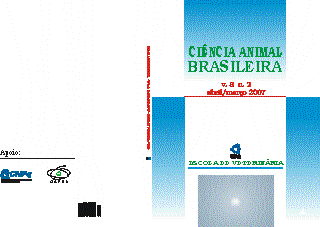EFFECT OF DIFFERENT SOURCES AND CONCENTRATIONS OF ZINC IN THE MINERAL MIXTURE ON PERFORMANCE AND SEMINAL CHARACTERISTICS OF GRAZING YOUNG BULLS
Keywords:
Minerais, Semen de tourosAbstract
Sixteen young Nellore bulls with approximately 26 months of age maintained o pasture were submitted to four different supplementations of zinc in the mineral mixture: Zn-0 (without zinc); Zn 30FO (30 mg of organic Zn/Kg); Zn 30FI (30 mg of inorganic Zn/Kg) and Zn 60FI (60 mg of inorganic Zn/Kg). Mineral mixture intake was measured and it was verified that the animals of Zn-0 had higher mi-neral mixture intake than the animals of other treatments, differing statistically (P <0,05) of Zn-30FO, Zn-30FI and Zn-60FI and that the animals of Zn-60FI had the lowest intake. Animals were weighted, blood and semen were collected and complete andrological analyses were done. No statistical differences were observed (P>0,05) among treatments for weight gain. Bulls of Zn-0 showed sperma-tozoids with less motility and vigor and higher chances of having spermatozoids with head, middle piece and proximal citoplasmatic drop defects. Animals supplemented with 60 mg of inorganic Zn/Kg showed higher chances of not having head, intermediate piece and proximal citoplasmatic drop defects on spermatozoids. Different sources and concentra-tions of zinc in the mineral mixture of young bulls didn’t affect the performance on experimental conditions, but did in the seminal characteristics.
KEY-WORDS: Growth, spermatozoids, inorganic zinc, organic zinc.
Downloads
Downloads
Published
How to Cite
Issue
Section
License
Copyright (c) 2007 Brazilian Animal Science/ Ciência Animal Brasileira

This work is licensed under a Creative Commons Attribution 4.0 International License.
Authors who publish with this journal agree to the following terms:
- Authors retain copyright and grant the journal right of first publication with the work simultaneously licensed under a Creative Commons Attribution License that allows others to share the work with an acknowledgement of the work's authorship and initial publication in this journal.
- Authors are able to enter into separate, additional contractual arrangements for the non-exclusive distribution of the journal's published version of the work (e.g., post it to an institutional repository or publish it in a book), with an acknowledgement of its initial publication in this journal.
- Authors are permitted and encouraged to post their work online (e.g. in institutional repositories or on their website) prior to and during the submission process, as it can lead to productive exchanges, as well as earlier and greater citation of published work (See The Effect of Open Access).




























